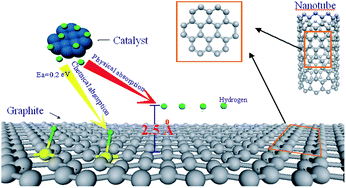Hydrogen spillover has emerged as a possible technique for achieving high-density hydrogen storage at near-ambient conditions in lightweight, solid-state materials. We present a brief review of our combined theoretical and experimental studies on hydrogen spillover mechanisms in solid-state materials where, for the first time, the complete mechanisms that dictate hydrogen spillover processes in transition metal oxides and nanostructured graphitic carbon-based materials have been revealed. The spillover process is broken into three primary steps: (1) dissociative chemisorption of gaseous H2 on a transition metal catalyst; (2) migration of H atoms from the catalyst to the substrate and (3) diffusion of H atoms on substrate surfaces and/or in the bulk materials. In our theoretical studies, the platinum catalyst is modeled with a small Pt cluster and the catalytic activity of the cluster is examined at full H atom saturation to account for the essentially constant, high H2 pressures used in experimental studies of hydrogen spillover. Subsequently, the energetic profiles associated with H atom migrations from the catalyst to the substrates and H atom diffusion in the substrates are mapped out by calculating the minimum energy pathways. It is observed that the spillover mechanisms for the transition metal oxides and graphitic carbon-based materials are very different. Hydrogen spillover in the transition metal oxides is moderated by massive, nascent hydrogen bonding networks in the crystalline lattice, while H atom diffusion on the nanostructured graphitic carbon materials is governed mostly by physisorption of H atoms. The effects of carbon material surface curvature on the hydrogen spillover as well as on hydrogen desorption dynamics are also discussed. The proposed hydrogen spillover mechanism in carbon-based materials is consistent with our experimental observations of the solid-state catalytic hydrogenation/dehydrogenation of coronene.

You have access to this article
 Please wait while we load your content...
Something went wrong. Try again?
Please wait while we load your content...
Something went wrong. Try again?


 Please wait while we load your content...
Please wait while we load your content...